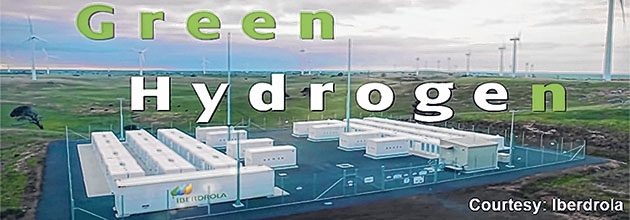Green Hydrogen for a clean environment
02 Jul 2024 23:47:10

N Munal Meitei
Green hydrogen is produced by electrolysis of water, using renewable electricity. Hydrogen is one of the most prevalent elements in nature and used in thermal, nuclear and electrical fields. Although there are various types of hydrogen energy, such as grey and blue hydrogen, the green hydrogen is the only type produced in a climate-neutral manner making it critical to reach net zero by 2050.
Green hydrogen's principal purpose is to help limit global warming to 1.5°C, reduce fossil fuel dependence by replacing grey hydrogen and provide for an expanded set of end-uses in specific economic sectors, sub-sectors and activities. But its main applications are likely to be in heavy industry, long-haul transport and long-term energy storage.
Green hydrogen accounted for less than 1% of total hydrogen production. The disadvantages are high cost, challenging in storage, difficulties in replacing the current infrastructures, high flammability and use of fossil fuels. Green hydrogen produced by electrolysis powered by solar power is about 25 times more expensive than that derived from hydrocarbons.
It’s right time to tap into green hydrogen’s potential to play a key role in tackling the climate crisis. Hydrogen is emerging as one of the leading options for storing energy from renewables with potentially transporting over long distances – from regions with abundant energy resources, to energy-hungry areas at far away. In order to expedite the shift from fossil fuels to green hydrogen energy, around 43 Nations have either established plans or roadmaps for a hydrogen economy, including offering financial incentives.
UN Climate Conference has acknowledged hydrogen as an important pillar of a net zero economy. United Nations under Green Hydrogen Catapult has the initiative to bring down the cost of green hydrogen and to doubling its production from 25 gigawatts set last year, to 45 gigawatts by 2027.
India joined the global race to develop a green hydrogen economy to bolster its energy security. After the release of India’s maiden green hydrogen policy, the budget outlay for this Scheme is Rs 4.96 billion till FY 2025-26.
Reliance Industries Limited (RIL) is betting big on green hydrogen to reduce the production cost below Rs 83/kg by the end of this decade with a capital outlay of Rs 75,000 crore over the next three years to develop manufacturing capacities. State-owned power generator, NTPC also aims to reduce production costs below Rs 166/kg by 2025-2026.
The Government is promoting renewable energy transmission and setting up green hydrogen near the consumption sources. However, the current policy incentives mainly focus on the supply side. Developers and investors need a visible off take pipeline for their product. The green hydrogen market in India has yet to have a dedicated Statewide network of interconnected hydrogen pipelines and for that we may use on our pre-existing gas network.
Green hydrogen energy has a low density and is a light element—lighter than air—which makes transportation challenging. For this reason, it is liquefied to take on a denser form. As of now, renewable energy sources such as solar and wind power has advanced significantly, but these two sources is very much dependent upon the availability of abundant sunlight and strong winds.
In terms of energy requirements, India’s economy is currently the third largest in the world and by 2030; the Nation’s demand is expected to increase by 35%. India aims to reach net zero emissions by 2070, in addition to other ambitious goals like achieving 500 GW of renewable energy capacity, 50% renewable energy to meet power requirements, one billion tons of cumulative emissions reduction by 2030 along with 45% reduction in the GDP’s emissions intensity.
As analyzed by NITI Aayog, India imports energy worth more than ?13,440 billion in 2022 and without a corrective action, these imports will be increasing over the years. Green hydrogen offers a impetus opportunity for India to relieve the country’s economy burden of Rs 19,320 billion when combined with renewable energy sources annually.
India has the potential to develop into a hub for the export of green hydrogen derivatives in this environment. Unlike many developed economies, the nation has the advantage of abundant land for expansion of renewable energy, a skilled labour force and relatively inexpensive renewable energy.
The green hydrogen production capacity in India is projected to reach 5 million metric tons per annum, significantly diminishing the reliance on fossil fuel imports. Successful mission attainment will curtail cumulative imports of fossil fuels worth Rs 1 trillion by 2030. This development is poised to attract over Rs 8 trillion in total investments and generate employment opportunities for more than 6 lakh individuals.
In India, the current push for hydrogen transition makes sense in light of the country’s greater goals for economic development, energy security and a low-carbon economy. The Ministry of New and Renewable Energy approved on 4th January 2023, an outlay of Rs 19,744 crore to make India, the Global Hub for production, usage and export of Green Hydrogen and its derivatives.
As a part to bring hydrogen to life, the first step is to increase this capacity – fast. Energy used for power and transport sectors that emitting for maximum CO2 should be decarbonized on priority. Once renewable energy capacities rise and excess capacity becomes available, green hydrogen could play a key role in decarbonization. It is true that it will still take many years to provide enough green hydrogen both to transition today’s dedicated demand for the fuel and the demand for net zero, Green Hydrogen is our future hope.
The writer is an environmentalist and can be reached at nmunall@yahoo.in